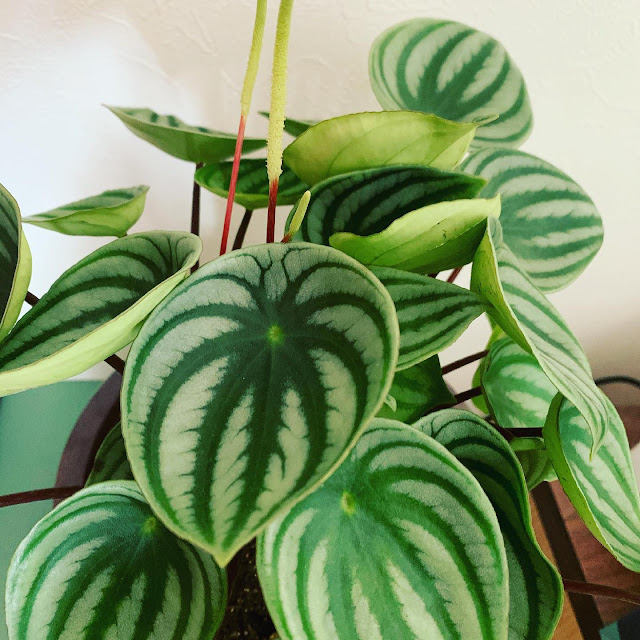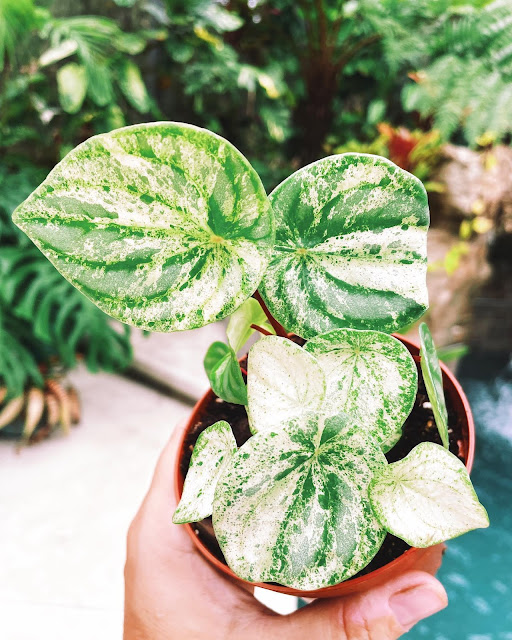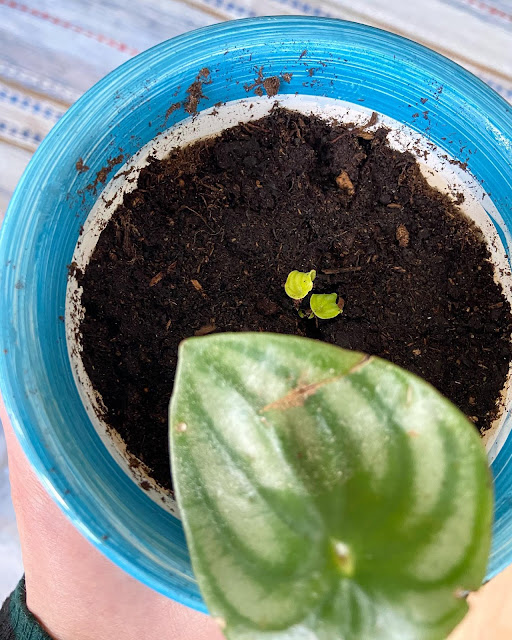Discover the Watermelon Peperomia : A Bright Spot
Watermelon peperomia, also known as "Peperomia argyreia," is a beautiful, low-maintenance plant native to South America. It is a member of the family "Piperaceae" and is known for its stunning leaves resembling a watermelon's skin. With its easy-going nature and attractive appearance, it's no wonder that watermelon peperomia has become a popular houseplant in recent years.
History:
Watermelon peperomia was first described by French botanist Louis Claude Richard in 1817 and was later classified by German botanist Friedrich Otto Wilhelm Diels in 1906. It was named after the Greek words "peperi," meaning "pepper," and "homoios," meaning "resembling." The plant was named this due to its close relation to the pepper plant and the appearance of its leaves, which resemble the skin of a watermelon.
Watermelon Peperomia Care:
Watermelon Peperomia Propagation:
Watermelon peperomia can be propagated through stem cuttings or leaf cuttings. To propagate through stem cuttings, cut a stem section of 4-6 inches and plant it in well-draining soil. Keep the soil moist but not wet and in a warm, bright location. Leaf cuttings can be taken by cutting a healthy leaf from the plant and placing it in a well-draining soil mixture. The leaf should be kept moist and in a bright, warm location until it has rooted and new growth appears.
How to Propagate Watermelon Peperomia:
Watermelon peperomia can be propagated through stem cuttings or leaf cuttings. To propagate through stem cuttings, cut a stem section of 4-6 inches and plant it in well-draining soil. Keep the soil moist but not wet and in a warm, bright location. Leaf cuttings can be taken by cutting a healthy leaf from the plant and placing it in a well-draining soil mixture. The leaf should be kept moist and in a bright, warm location until it has rooted and new growth appears.
Watermelon Peperomia Flowers:
Variegated Watermelon Peperomia:
If your watermelon peperomia is drooping, it may be due to one of the following reasons:
Over-watering: If you water your plant too frequently or keep the soil too moist, the roots can become waterlogged and start to rot. This will cause the plant to wilt and droop.
Under-watering: On the other hand, if you forget to water your plant or let the soil dry out completely, the plant will start to sag and wilt.
Lack of light: Watermelon peperomia needs bright, indirect light to thrive. It will start to sag and wilt if it's not getting enough light.
Pests or Diseases: Pests like spider mites or diseases like root rot can also cause watermelon peperomia to droop.
It's essential to identify the cause of the drooping and take appropriate action. If you think your plant is overwatered, let the soil dry out before watering again. If you think it's under-watered, give it a deep watering and then be more consistent with watering in the future. If you suspect pests or diseases, isolate the plant and treat it accordingly.
How To Care For Watermelon Peperomia
Light: Provide bright, indirect light, but avoid direct sunlight, as this can scorch the leaves.
Watering: Water regularly, but allow the soil to dry out slightly between waterings. Over-watering can cause root rot.
Soil: Use well-draining soil to prevent water from sitting in the soil for too long.
Humidity: Watermelon peperomia prefers higher humidity levels but can also tolerate average household humidity.
Fertilizer: Feed your watermelon peperomia plant with a balanced, water-soluble fertilizer every 2-3 weeks during the growing season.
Pruning: Prune back leggy stems to encourage a fuller, bushier plant.
Pests: Keep an eye out for common houseplant pests like spider mites or mealybugs and treat them promptly if detected.
Following these care tips can help your watermelon peperomia thrive and maintain its healthy appearance.
Mini Watermelon Peperomia
Light: Like most peperomias, Mini Watermelon Peperomia prefers bright, indirect light but can tolerate low light conditions.
Watering: Water when the top inch of soil is dry, but be careful not to over-water, as this can lead to root rot.
Soil: Use well-draining soil and make sure the pot has proper drainage holes.
Humidity: This plant is relatively tolerant of a range of humidity levels but prefers higher humidity levels.
Fertilizer: Fertilize every 2-3 weeks during the growing season with a balanced, water-soluble fertilizer.
Propagation: Mini Watermelon Peperomia can be propagated through stem cuttings or division.
Size: Mini Watermelon Peperomia typically grows about 6-8 inches tall and wide, making it an excellent choice for small spaces or as a desk plant.
With its small size, attractive foliage, and easy-to-care-for nature, Mini Watermelon Peperomia is a popular choice for houseplant enthusiasts and first-time plant owners.
Large Watermelon Peperomia
Overwatered Watermelon Peperomia
An overwatered Watermelon Peperomia may show the following symptoms:
Yellowing leaves: The lower leaves will turn yellow and eventually drop off.
Wilting: The plant may appear wilted even though the soil is wet.
Root rot: The roots will start to rot, causing the plant to become unstable.
Brown spots: Brown spots may appear on the leaves.
To save an overwatered Watermelon Peperomia, you can follow these steps:
Remove the plant from its pot and inspect the roots. If they are black and mushy, they have been affected by root rot and need trimmed.
Let the roots dry out entirely before replanting the Watermelon Peperomia in a well-draining potting mix.
Water the plant sparingly until it has recovered.
Reduce the watering frequency and ensure that the soil dries out slightly between waterings.
Provide proper lighting and air circulation to prevent fungal diseases from developing.
It may take some time for the plant to recover, but with proper care, it should bounce back.
Watermelon Peperomia Leaves Curling
Leaves curling on a watermelon peperomia plant can be due to one of the following reasons:
Over-watering: If the soil is too moist, the roots can become waterlogged, which can cause the leaves to curl.
Under-watering: On the other hand, if the soil is too dry, the leaves can also curl in response to stress.
Pests: Pests like spider mites or thrips can cause leaves to curl, turn yellow, and become deformed.
Light: The leaves may curl if the plant is not getting enough light or is getting too much direct sunlight.
Temperature: Sudden changes in temperature or exposure to drafty conditions can cause leaves to curl.
It's essential to identify the cause of the curling and take appropriate action. If you think your plant is being overwatered, let the soil dry out slightly before watering again. If you think it's under-watered, give it a deep watering and then be more consistent with watering in the future. If you suspect pests, isolate the plant and treat it accordingly. If the light or temperature is the issue, adjust the environment to provide the best conditions for the plant to thrive.
Conclusion:
Watermelon peperomia is a beautiful, low-maintenance plant that is easy to care for and propagate. Its unique leaves and easy-going nature make it a great addition to any indoor or outdoor garden. Whether
Frequently Asked Questions about Watermelon Peperomia:
What is watermelon peperomia?
Watermelon peperomia is a tropical houseplant native to South America, known for its unique leaves resembling a watermelon's skin.
How do I care for watermelon peperomia?
Watermelon peperomia requires well-draining soil, regular watering, and bright, indirect light. It is also sensitive to over-watering, so letting the soil dry out slightly between waterings is essential.
Can watermelon peperomia be propagated?
Yes, watermelon peperomia can be propagated through stem cuttings or leaf cuttings.
Does watermelon peperomia produce flowers?
Watermelon peperomia produces small, greenish-white flowers on spikes, but the flowers are not the main attraction of this plant.
What is variegated watermelon peperomia?
Variegated watermelon peperomia is a cultivar of watermelon peperomia that has leaves with white, yellow, or cream variegation.
How much light does watermelon peperomia need?
Watermelon peperomia requires bright, indirect light, but it can also tolerate some shade.
Can watermelon peperomia be grown outdoors?
Yes, watermelon peperomia can be grown outdoors in partial shade.
Is watermelon peperomia a low-maintenance plant?
Yes, watermelon peperomia is a low-maintenance plant that is easy to care for.
Visit Rediscover360 for more amazing plants.
Discover The Nerve Plant (Fittonia)










Comments
Post a Comment